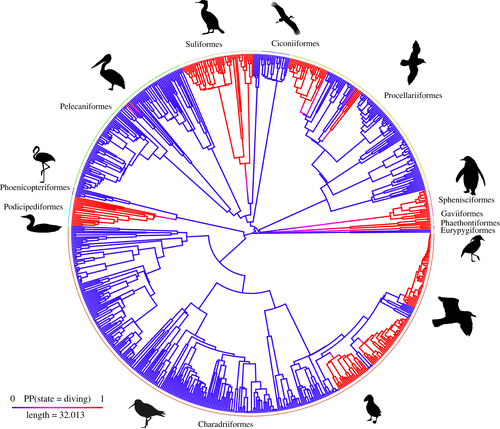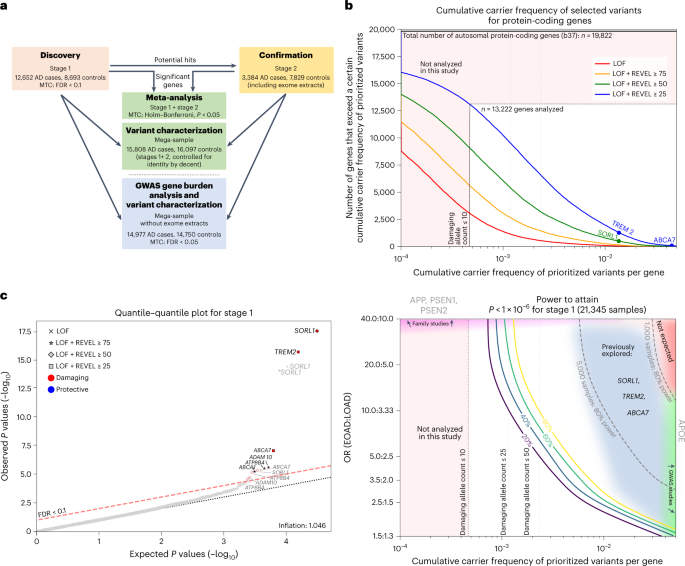潜水鳥は進化の過程で行き詰まった可能性があるという研究結果が発表された。 Research suggests diving birds may have evolved into an evolutionary dead-end.
2022-12-19 バース大学
鳥類において潜水能力は極めて稀であり、水鳥の727種のうち、潜水して食料を狩るのは3分の1以下である。
進化学者のジョシュア・タイラー博士とジェーン・ヤンガー博士は、現代の水鳥における潜水の進化を研究し、潜水が鳥類の身体的特徴(形態)、種の多様性を高める進化(種分化率)、種の絶滅のしやすさなどにどのような影響を与えたかを調査しました。
この研究は『Proceedings of the Royal Society B』に掲載され、潜水は14回独立して進化したこと、一度潜水能力を獲得したグループはその後の進化でその特性が逆転することはないことが明らかにされた。また、潜水する鳥の体格は、潜水の種類によって異なる進化を遂げていることがわかった。
ペンギンやパフィンのような翼を持つ鳥は、翼を使って水中を移動する。これらの鳥は、泳ぐのに適した大きな体格を持つ傾向がある。
カワウなどの「フットダイブ」をする鳥は、足を蹴って泳ぎ、体格も同様にウイングダイバーより大きくなります。
一方、カモメやカツオドリのような「プランジダイバー」と呼ばれる鳥は、空中から垂直に飛び込んで獲物を捕らえる。これらの種は、泳ぐよりも飛ぶことに適しているため、体格がより制限される傾向があることがわかった。
この研究では、潜水する鳥としない鳥の種分化率に大きな違いは見られなかったが、潜水する鳥の多くは、しない種よりも絶滅しやすいようであることもわかった。
<関連情報>
- https://www.bath.ac.uk/announcements/diving-birds-are-more-prone-to-extinction-says-new-study/
- https://royalsocietypublishing.org/doi/10.1098/rspb.2022.2056
行き止まりへの潜水:潜水の非対称進化が水鳥の多様性と格差のシフトを促進する Diving into a dead-end: asymmetric evolution of diving drives diversity and disparity shifts in waterbirds
Joshua Tyler and Jane L. Younger
Proceedings of the Royal Society B Published:14 December 2022
DOI:https://doi.org/10.1098/rspb.2022.2056

Abstract
Diving is a relatively uncommon and highly specialized foraging strategy in birds, mostly observed within the Aequorlitornithes (waterbirds) by groups such as penguins, cormorants and alcids. Three key diving techniques are employed within waterbirds: wing-propelled pursuit diving (e.g. penguins), foot-propelled pursuit diving (e.g. cormorants) and plunge diving (e.g. gannets). How many times diving evolved within waterbirds, whether plunge diving is an intermediate state between aerial foraging and submarine diving, and whether the transition to a diving niche is reversible are not known. Here, we elucidate the evolutionary history of diving in waterbirds. We show that diving has been acquired independently at least 14 times within waterbirds, and this acquisition is apparently irreversible, in a striking example of asymmetric evolution. All three modes of diving have evolved independently, with no evidence for plunge diving as an intermediate evolutionary state. Net diversification rates differ significantly between diving versus non-diving lineages, with some diving clades apparently prone to extinction. We find that body mass is evolving under multiple macroevolutionary regimes, with unique optima for each diving type with varying degrees of constraint. Our findings highlight the vulnerability of highly specialized lineages during the ongoing sixth mass extinction.


